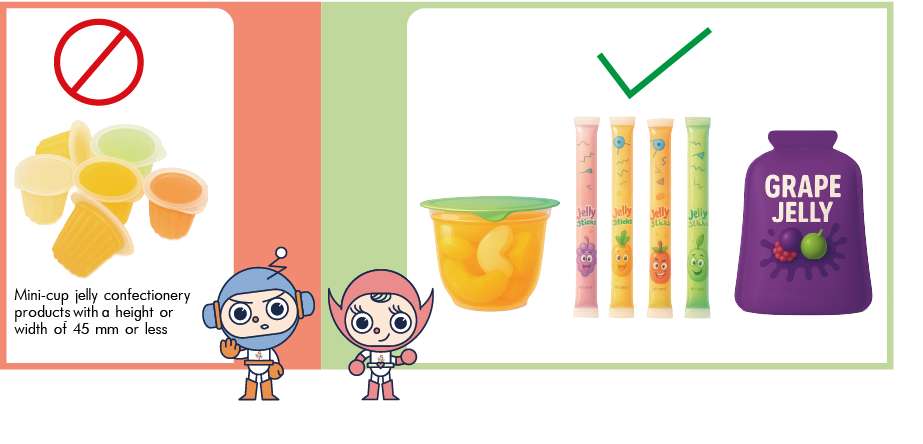
Food Safety Focus (226th Issue, May 2025) – Article 1
Choking Risks Associated with Konjac Jelly: What You Need to Know
Reported by Ms. Shuk-man CHOW, Scientific Officer,
Risk Assessment Section, Centre for Food Safety
While any food can pose a choking hazard, certain firm, small items that do not dissolve easily, such as mini-cup konjac jellies, may present a higher risk to young children and the elderly if not consumed properly. This article aims to outline measures to mitigate the choking risks associated with konjac jelly.
Choking Risks of Mini-cup Konjac Jellies
Konjac, also known as conjac, konnyaku, yam flour, glucomannan, or by its INS number1 425 (E425), is a common ingredient in jelly confectionery. The Codex Alimentarius Commission considers konjac flour a safe additive, permitting its use as a thickener, emulsifier, stabiliser and more in a range of foods. However, unlike gelatin-based jellies, konjac jelly is much firmer and less likely to dissolve in the mouth.
Some konjac jellies are packed in semi-rigid, dome-shaped mini-cups designed for easy consumption, allowing consumers to either suck the jelly out in one bite or squeeze the cup to project it into the mouth. Mini-cups that are 45 mm or less in height or width allow the konjac jelly to be eaten whole or sucked from the containers. With its smooth, slippery surfaces, konjac jelly can slide to the back of the mouth and may become lodged in the throat, acting as a plug that obstructs the airway and increases the risk of choking.

Figure : Konjac jellies come in various sizes and shapes.
1The Codex Alimentarius Commission has prepared the International Numbering System for Food Additives (INS), which provides an agreed international numerical system for identifying food additives.
Mitigating Choking Risks of Konjac Jelly
Proposal on regulation of konjac-containing jelly confectionery
To address this concern, the Centre for Food Safety (CFS) has proposed regulating the sale of jelly confectionery products containing konjac through legislative measures. The proposed amendments stipulate that if a mini-cup jelly confectionery product has a height or width of 45 mm or less, it shall not contain konjac. Furthermore, all prepackaged konjac-containing jelly confectionery products are required to be labelled with a warning statement on prevention of choking hazard in both Chinese and English:
注意:勿一口吞食,長者及兒童需在監護下食用。
Caution: Do not swallow whole. Elderly and children must consume under supervision.
The regulatory proposal is available on the CFS’s designated webpage. Members of the public and the trade are welcome to visit for more information and offer their views on or before 8 June 2025.
Health education
The CFS has been promoting health education messages on prevention of food choking through its website, seminars, social media and posters. In addition, the CFS in collaboration with the Education Bureau, has issued a letter to schools, advising them to stop providing or selling mini-cup konjac jellies, such as in tuck shops and school canteens, to prevent potential choking risks before the implementation of the proposed regulatory measures.
Moreover, the CFS has produced an educational video and a video advertisement to highlight common choking hazards and promote safe eating habits. The CFS will continue to organise school talks and disseminate information online to raise public awareness about choking prevention and strengthen education among ethnic minorities.
Choking risks can be reduced by adopting the following safe eating habits:
- Avoid eating while talking, laughing or running.
- Do not suck mini-cup konjac jelly directly from the packaging.
- Cut konjac jelly into smaller pieces and use a spoon.
- Take small bites, chew well, and swallow between bites.
Key Points to Note
- Konjac jellies are safe for consumption; however, improper consumption of mini-cup konjac jellies may pose a choking risk.
- The Government is proceeding with the proposed legislative amendments to prohibit the sale of mini-cup jelly confectionary.
- Practicing good eating habits can reduce the risk of choking.
Advice to the Public
- Do not give mini-cup konjac jellies to young children or the elderly.
- Supervise young children and the elderly while they are eating non-mini-cup konjac jellies to ensure safe consumption.
- Follow the consumption advice on the packaging of konjac jellies.
Advice to the Trade
- Stop the sale of mini-cup konjac jellies with a height or width of 45 mm or less before the implementation of the proposed amendments.
- Provide clear choking warning statements on the packaging to remind consumers to exercise caution.

